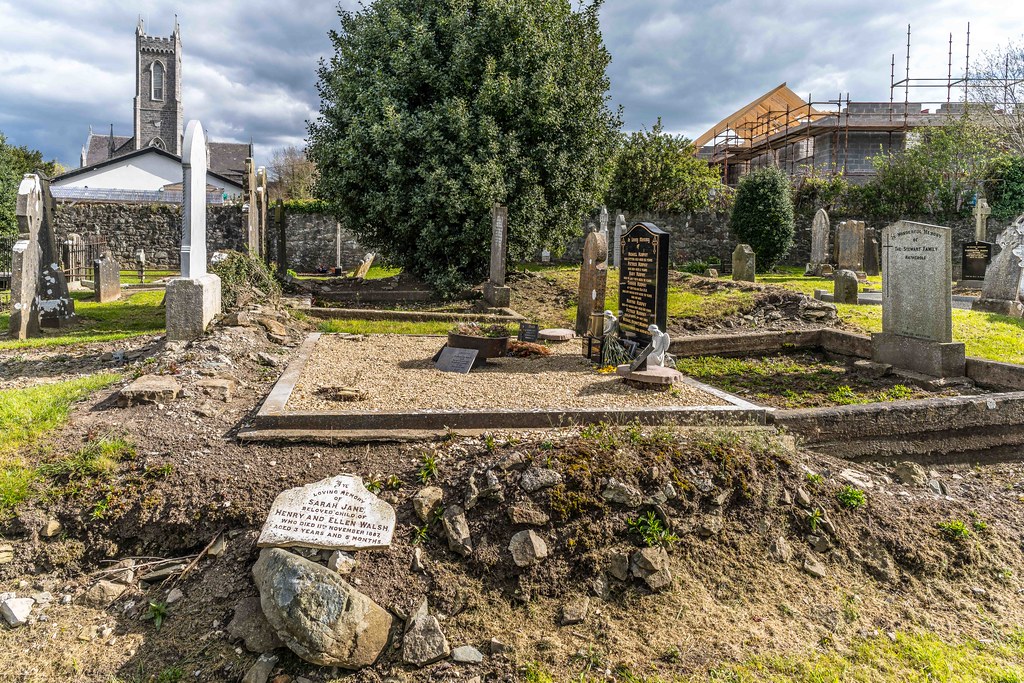BROKEN GRAVESTONEPHOTOGRAPHED IN APRIL 2016
Sarah Jane Beloved Child Of Henry And Ellen Walsh
It is a pity to see an old gravestone in this condition.
Having visited many old graveyards I have noticed that many gravestones do you last long and much to my surprise there is a huge difference between granite and marble. Marble is a sedimentary stone and will break down quickly when exposed to the weather, while granite is an igneous rock and will show little to no change for centuries.
"In Loving Memory of Sarah Jane Beloved child of Henry and Ellen Walsh who died 11th November 1887 aged 3 years and 5 months"
It is a pity to see an old gravestone in this condition.
Having visited many old graveyards I have noticed that many gravestones do you last long and much to my surprise there is a huge difference between granite and marble. Marble is a sedimentary stone and will break down quickly when exposed to the weather, while granite is an igneous rock and will show little to no change for centuries.
"In Loving Memory of Sarah Jane Beloved child of Henry and Ellen Walsh who died 11th November 1887 aged 3 years and 5 months"
A cemetery may follow national codes of practice or independently prescribe the size and use of certain materials, especially in a conservation area. Some may limit the placing of a wooden memorial to six months after burial, after which a more permanent memorial must be placed. Others may require stones of a certain shape or position to facilitate grass-cutting by m, or hand-held cutters. Headstones of granite, marble and other kinds of stone are usually created, installed, and repaired by monumental masons. Cemeteries require regular inspection and maintenance, as stones may settle, topple and, on rare occasions, fall and injure people; or graves may simply become overgrown and their markers lost or vandalised.
Restoration is a specialised job for a monumental mason. Even overgrowth removal requires care to avoid damaging the carving. For example, ivy should only be cut at the base roots and left to naturally die off, never pulled off forcefully. Many materials have been used as markers.
TYPES OF STONE USED:
Granite. Granite is a hard stone and requires skill to carve by hand. Modern methods of carving include using computer-controlled rotary bits and sandblasting over a rubber stencil. Leaving the letters, numbers and emblems exposed on the stone, the blaster can create virtually any kind of artwork or epitaph.
Marble and limestone. Both limestone and marble take carving well. Marble is a recrystallised form of limestone. The mild acid in rainwater can slowly dissolve marble and limestone over time, which can make inscriptions unreadable. Portland stone was a type of limestone commonly used in England—after weathering, fossiliferous deposits tend to appear on the surface. Marble became popular from the early 19th century, though its extra cost limited its appeal.
Sandstone. Sandstone is durable, yet soft enough to carve easily. Some sandstone markers are so well preserved that individual chisel marks are discernible, while others have delaminated and crumbled to dust. Delamination occurs when moisture gets between the layers of the sandstone. As it freezes and expands the layers flake off. In the 17th century, sandstone replaced field stones in Colonial America. Yorkstone was a common sandstone material used in England.
Slate. Slate can have a pleasing texture but is slightly porous and prone to delamination. It takes lettering well, often highlighted with white paint or gilding. Swithland slate from Charnwood Forest, Leicestershire, England, was used for a large number of very fine gravestones from the later 17th century into the 19th century. The gravestones are found throughout Leicestershire and in neighbouring counties.
Restoration is a specialised job for a monumental mason. Even overgrowth removal requires care to avoid damaging the carving. For example, ivy should only be cut at the base roots and left to naturally die off, never pulled off forcefully. Many materials have been used as markers.
TYPES OF STONE USED:
Granite. Granite is a hard stone and requires skill to carve by hand. Modern methods of carving include using computer-controlled rotary bits and sandblasting over a rubber stencil. Leaving the letters, numbers and emblems exposed on the stone, the blaster can create virtually any kind of artwork or epitaph.
Marble and limestone. Both limestone and marble take carving well. Marble is a recrystallised form of limestone. The mild acid in rainwater can slowly dissolve marble and limestone over time, which can make inscriptions unreadable. Portland stone was a type of limestone commonly used in England—after weathering, fossiliferous deposits tend to appear on the surface. Marble became popular from the early 19th century, though its extra cost limited its appeal.
Sandstone. Sandstone is durable, yet soft enough to carve easily. Some sandstone markers are so well preserved that individual chisel marks are discernible, while others have delaminated and crumbled to dust. Delamination occurs when moisture gets between the layers of the sandstone. As it freezes and expands the layers flake off. In the 17th century, sandstone replaced field stones in Colonial America. Yorkstone was a common sandstone material used in England.
Slate. Slate can have a pleasing texture but is slightly porous and prone to delamination. It takes lettering well, often highlighted with white paint or gilding. Swithland slate from Charnwood Forest, Leicestershire, England, was used for a large number of very fine gravestones from the later 17th century into the 19th century. The gravestones are found throughout Leicestershire and in neighbouring counties.
SORRY FOR THE DELAY
THE GREEN MENU OPTIONS ARE MOBILE FRIENDLY AND ARE FASTER SO THEY ARE RECOMMENDED. THE RED MENU OPTIONS ARE SOMEWHAT SLOWER DEPENDING ON YOUR DEVICE OR BROWSER AND ARE MORE SUITABLE FOR DESKTOPS AND LAPTOPS. THE BLUE OPTIONS ARE PAGE LINKS AND WILL BE PHASED OUT GOING FORWARD
